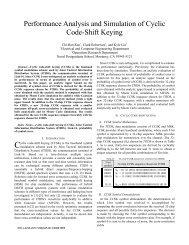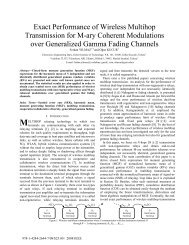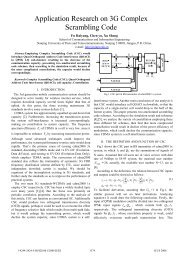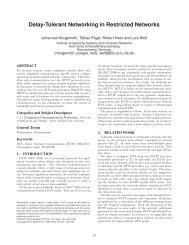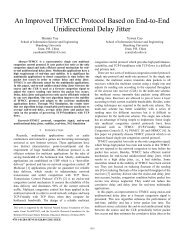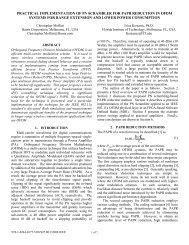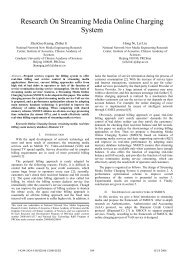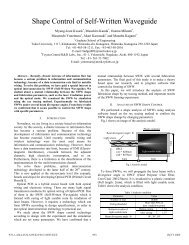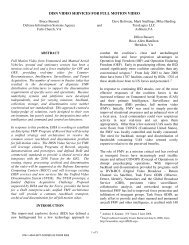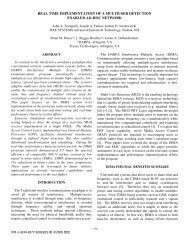SECURE ATC SURVEILLANCE FOR MILITARY APPLICATIONS
SECURE ATC SURVEILLANCE FOR MILITARY APPLICATIONS
SECURE ATC SURVEILLANCE FOR MILITARY APPLICATIONS
You also want an ePaper? Increase the reach of your titles
YUMPU automatically turns print PDFs into web optimized ePapers that Google loves.
978-1-4244-2677-5/08/$25.00 ©2008 IEEE<br />
<strong>SECURE</strong> <strong>ATC</strong> <strong>SURVEILLANCE</strong> <strong>FOR</strong> <strong>MILITARY</strong> <strong>APPLICATIONS</strong><br />
This paper presents a system in concept development that<br />
combines the integrity of the civil Automatic Dependant<br />
Surveillance – Broadcast (ADS-B) system for air-to-air<br />
conflict avoidance and air traffic management (ATM)<br />
surveillance with the military secure Mark XIIA Mode 5<br />
Identification Friend or Foe (IFF) system as the data link.<br />
This new system, coined Military ADS-B (MADS-B),<br />
expands the traditional IFF surveillance data of range,<br />
azimuth, altitude, and identity (ID) to include each<br />
platform’s dynamic state of motion and status. This selfreporting<br />
system significantly improves positioning and<br />
status data between Tri-Service platforms and with Allies –<br />
who are also transitioning to the common Mode 5 system.<br />
Beyond MADS-B’s securing of ADS-B data, it enables<br />
overcoming other surveillance and navigation shortfalls<br />
through future software based message additions. The<br />
paper summarizes ADS-B operations, the conversion of<br />
data to the Mode 5 Level 2 formats, and examples of<br />
message extensions providing surveillance enhancements.<br />
INTRODUCTION<br />
The objective of the secure surveillance capability is to<br />
bring all the benefits of the civil air traffic management<br />
(ATM) Automatic Dependent Surveillance – Broadcast<br />
(ADS-B) system to the military Identification Friend or<br />
Foe (IFF) system. The proposed solution improves system<br />
integrity, enables common flight procedures, and increases<br />
link efficiency.<br />
Civilian air traffic control (<strong>ATC</strong>) and military IFF share<br />
dedicated communications channels, with an exclusive<br />
international frequency allocation of 1030 MHz for the<br />
interrogations (uplink) and 1090 MHz for the replies<br />
(downlink). They have evolved from radar beacon based<br />
question and answer systems. The initial civil component<br />
is known as the Air Traffic Control Radar Beacon System<br />
(<strong>ATC</strong>RBS). Legacy military IFF supplemented the<br />
<strong>ATC</strong>RBS modes with an unsecured Selective<br />
Identification Facility (SIF) for additional platform data in<br />
addition to a secure ID only mode. As civil air traffic<br />
density increased, an addressed interrogation mode, Mode<br />
S, was developed to obtain platform data and reduce<br />
system self-interference. It also introduced a self reporting<br />
acquisition mode to supplement the question and answer<br />
mode. Increasing traffic density continued to grow,<br />
challenging the paradigm of question and answer ATM<br />
Larry Kenney<br />
Joe Dietrich<br />
Jerry Woodall<br />
Raytheon Network Centric Systems<br />
Towson, MD<br />
1 of 6<br />
systems. ADS-B is the civil solution to the Mode S overinterrogation<br />
and Traffic Alert and Collision Avoidance<br />
System (TCAS) generated false replies unsynchronized to<br />
interrogator transmissions (fruit) that jeopardize <strong>ATC</strong><br />
integrity. ADS-B is the affordable solution to safely<br />
increase traffic density, ensure conflict avoidance with<br />
free-flight, and manage self-interference.<br />
IFF over-interrogation also generates excess fruit that not<br />
only jeopardizes IFF operational integrity, but also<br />
increases fratricide risk and produces surveillance gaps. A<br />
secure form of ADS-B that complements IFF and offers a<br />
common set of training, tactics, and procedures with<br />
seamless process for military aviators to transition from<br />
the peace-time civil airspace to the hostile battle space.<br />
With self-reporting reducing interrogation rates, the ADS-<br />
B can efficiently use the signal bandwidth at 1090 MHz to<br />
transmit an increased amount of information about the<br />
vehicle position, velocity, and status. A secure ADS-B like<br />
system of surveillance and air-to-air conflict avoidance can<br />
be can be the system that provides superior IFF<br />
performance into the next century, overcoming the<br />
operational utility shortfalls in the question and answer<br />
component of the IFF system.<br />
ADS-B OVERVIEW<br />
The ADS-B system is strongly positioned in universal<br />
situational awareness. It is based on the concept of aircraft<br />
self-reporting their geodetic location, both in the air and on<br />
the ground. It has been developed and peer reviewed<br />
internationally over the last 20 years. ADS-B builds on<br />
Mode S with requirements established by national<br />
authorities such as the FAA, RTCA, EUROCAE, and<br />
ICAO. RTCA/DO-260A [1] establishes the minimum<br />
operational standards (MOPS) for airborne equipment for<br />
ADS-B utilizing 1090 MHz Mode S Extended Squitter<br />
(1090ES).<br />
Since the goal is to routinely use the ADS-B self reports as<br />
a primary source of aircraft surveillance, the US and other<br />
nations plan to replace the majority of <strong>ATC</strong> interrogators<br />
with ADS-B ground receiving stations by ~2018. Some<br />
nations plan to bypass upgrades with Mode S interrogators<br />
and go directly from the <strong>ATC</strong>RBS to ADS-B as the<br />
designated surveillance upgrade for the future.
ADS-B will be required internationally for civil<br />
<strong>ATC</strong>/ATM. A clear case has been made for the installation<br />
of ADS-B in military platforms [2, 3]. However, ADS-B<br />
dictates that all surveillance be open, and therefore nonsecure.<br />
This is a recognized vulnerability, but civil<br />
authorities accept it in civil environments. Note that<br />
1090ES ADS-B messages are equally important military<br />
surveillance input.<br />
The open nature of the ADS-B data transmission is<br />
incompatible with IFF objectives in a hostile environment.<br />
It would be vulnerable to the classic IFF threats of<br />
spoofing and exploitation. Spoofers could attack the<br />
system by generating false reports containing contrived<br />
position data. Exploiters could listen to the ADS-B reports<br />
to easily track and then advantageously attack the<br />
vulnerable aircraft.<br />
MARK XIIA MODE 5 OVERVIEW<br />
The new Mark XIIA Mode 5 waveform for airborne<br />
Identification Friend or Foe (IFF) offers the first<br />
significant upgrade to airborne cooperative identification<br />
systems since the Mark XII Mode 4 development in the<br />
1960s. The US military is preparing to field this new<br />
international standard which features secure data<br />
transmission in addition to providing high assurance friend<br />
determination. Mode 5 uses minimum shift keying (MSK)<br />
modulation and spread spectrum techniques to realize a<br />
processing gain waveform. The waveform defined by<br />
STANAG 4193 [4] includes error control and methods for<br />
reducing self-interference. Security is provided by a Type<br />
1 algorithm embedded in a programmable crypto engine.<br />
IFF Mode 5 capabilities are defined for four levels. Levels<br />
1 and 2 are well defined and are supported by equipment<br />
being delivered now. Levels 3 and 4 have less definition<br />
and are intended for capability growth.<br />
Data from<br />
GNSS/GPS<br />
& Aircraft<br />
Military Aircraft Transponder<br />
ADS-B Class B<br />
Register Data<br />
Generation<br />
Added for ADS-B<br />
M5 Encryption<br />
& M5L2 MSK<br />
Waveform<br />
Mode S DF-17<br />
PPM Modulated<br />
Waveform<br />
Added for MADS-B<br />
2 of 6<br />
Mode 5 Level 1 (M5L1) is the synchronous question and<br />
answer mode. It offers significant improvements in secure<br />
friend determination over the legacy Mode 4, and includes<br />
a secure data transmission capability. With M5L1, an IFF<br />
interrogator can simultaneously determine friend status<br />
and securely query altitude, mission code, platform<br />
identification number (PIN), and national origin (NO).<br />
M5L1 introduces the lethal interrogation mode, where a<br />
reply is required from a transponder even when it is in<br />
standby mode.<br />
Mode 5 Level 2 (M5L2) is a new asynchronous mode for<br />
secure self reporting. Report formats include ADS-B like<br />
GPS data in 77 bit tactical data report messages. There are<br />
two squittering (self-reporting) rates, a long term low rate<br />
squitter, similar to the ADS-B squitters, and a short<br />
duration high rate squitter, which can be triggered by a<br />
scanning beam interrogator.<br />
<strong>MILITARY</strong> <strong>SECURE</strong> ADS-B<br />
For the military secure ABS-B (MADS-B), we recommend<br />
combining the tracking accuracy and integrity of ADS-B<br />
data with the security of the M5L2 waveform as the<br />
available, secure-interoperable military communications<br />
link. The ADS-B data would be reformatted into a subset<br />
of the 8 unused M5L2 formats. The original formats would<br />
be undisturbed. All of the M5L1 formats would also be<br />
retained for interoperability and lethal use.<br />
Figure 1 shows a simplified block diagram of a MADS-B<br />
capable transponder. The core 1090ES, Mode S Enhanced<br />
Surveillance, modes are current equipment capabilities<br />
realized in the pulse position modulation (PPM) and<br />
demodulation functions in the transponder transmitter and<br />
interrogator receiver.<br />
M5L2 MSK<br />
Demodulation &<br />
M5 Decryption<br />
Tracking & Status<br />
Data over Either Path<br />
Military Aircraft Class A Transponder<br />
or Ground/Surface Class C Receiver<br />
Mode S DF-17<br />
PPM Waveform<br />
Decoding<br />
Figure 1 MADS-B System Components<br />
ADS-B<br />
and<br />
MADS-B<br />
Target Data<br />
to Display<br />
ADS-B Class A<br />
Track & Display<br />
Generation
For ADS-B support, data is accepted from aircraft’s<br />
navigation and global navigation satellite system (GNSS)<br />
source, processed and loaded into the Comm-B Data<br />
Select (BDS) registers. In ADS-B operation, data from<br />
specified registers are sampled at random intervals<br />
(~2/second rate) and used to create the 112 bit downlink<br />
message. For military-secure MADS-B operation, the data<br />
in the 112 bit downlink message would be remapped into<br />
the 77 bit tactical data field payload of the M5L2 message.<br />
That M5L2 message would then be encrypted and<br />
modulated in the same manor as any other M5L2<br />
messages.<br />
On the receiving end, there is a MADS-B/ADS-B Class A<br />
track and report generator. It accepts data from either the<br />
demodulated 1090ES replies or the decrypted,<br />
demodulated, and reformatted data from selected M5L2<br />
messages. The track and report generator function is<br />
essentially independent of the source of the ADS-B data.<br />
With judicious re-formatting of the data from the normal<br />
1090ES payload to the M5L2 payload, MADS-B provides<br />
all of the advantages of the civil ADS-B operational use<br />
and integrity, while providing critical military grade<br />
security.<br />
MADS-B MODE 5 LEVEL 2 <strong>FOR</strong>MATS<br />
Mode 5 provides up to 16 level 2 message formats, 11 of<br />
which are assigned to standard Mode 5 interrogate-reply<br />
functions and 5 are proposed for assignment to MADS-B<br />
functions. The Mode 5 level 2 formats proposed for<br />
MADS-B are shown in Table 1.<br />
Table 1 Mode 5 Level 2 Message Formats 24 - 31<br />
Squitter Transmission<br />
Format Subformat<br />
Used for Report Type<br />
24 None Air Surveillance Airborne Position<br />
25 None Surface/Ground<br />
Surveillance<br />
Surface Position<br />
26 0 Air Surveillance Airborne<br />
Velocity*<br />
1 Platform Type Airborne<br />
& Status Capability**<br />
2 Surface<br />
Capability**<br />
3 Reserved for IFF & Military Status<br />
4-7 Unassigned MADS-B Subformats<br />
27-28 Reserved for MADS-B***<br />
* Required with Format 24.<br />
** Supplements Formats 24 and 25.<br />
*** Formats 29-31 reserved for standard M5L2 future use<br />
The airborne position and the airborne velocity report<br />
types are explored in detail below to show the reformatting<br />
of the ADS-B data into the M5L2 payload constraints.<br />
3 of 6<br />
AIRBORNE POSITION<br />
Figure 2 illustrates the mapping of the 1090ES, downlink<br />
format (DF) 17 airborne position from the BDS register<br />
(0,5) into the MADS-B M5L2 format 24. Recall that the<br />
payload for the M5L2 is limited to 77 bits and that the long<br />
1090ES formats are 112 bits long.<br />
112 Bits<br />
Mode S DF=17<br />
Airborne Position (BDS 0,5)<br />
5<br />
3<br />
24<br />
5<br />
2<br />
1<br />
12<br />
1<br />
1<br />
17<br />
17<br />
24<br />
DF Code<br />
CA Status<br />
AA Mode S<br />
Address<br />
Type Code<br />
Surv Status<br />
Single Ant<br />
Altitude<br />
Time (T)<br />
CPR Format<br />
CPR<br />
Encoded<br />
Latitude<br />
CPR<br />
Encoded<br />
Longitude<br />
PI<br />
Parity<br />
Identity Code<br />
1<br />
2<br />
3<br />
4<br />
5<br />
Identical<br />
6<br />
5<br />
14 - MIL PIN<br />
19 Address<br />
5 - Nat Origin<br />
4 Add’l Addr<br />
4 Type Code<br />
2 Surv Status<br />
12<br />
1 Time (T)<br />
1 CPR Format<br />
CPR<br />
17 Encoded<br />
Latitude<br />
17<br />
MADS-B<br />
Format 24<br />
Altitude<br />
CPR<br />
Encoded<br />
Longitude<br />
Figure 2 Airborne Position Report<br />
Header<br />
The most critical data which is the essence of the position<br />
report is identically formatted in the MADS-B position<br />
report. The 2 bit surveillance status field (Surv Status)<br />
signals emergency and identity pulse (IP) in four states.<br />
The 12 bit altitude is the GNSS height. The time flag field<br />
signals the synchronization method. The compact position<br />
report (CPR) format flag signals whether the odd or even<br />
CPR data is included in this report. The latitude and<br />
longitude data are CPR encoded.<br />
The Mode S DF and civil aviation (CA) status codes (1)<br />
are not mapped into the MADS-B report. The differences<br />
begin with (2) the 24 bit aircraft address (AA) field being<br />
dropped in favor of the 19 bits of the military platform<br />
identification number (PIN) and national origin (NO),<br />
along with (6) 4 additional bits reserved for military<br />
identifier expansion. The type code (3) is compacted from<br />
5 bits to 4 bits to report all accuracy and integrity levels of<br />
ADS-B airborne position except for one type code. The<br />
single antenna flag (4) is not mapped into the MADS-B<br />
report because military aircraft typically have dual<br />
antennas.<br />
77 Bit Tactical Data Payload
The parity identity code (PI) is dropped because the M5L2<br />
has a CRC integrity check on the data within the<br />
cryptography, and the waveform has Reed-Solomon error<br />
correction coding on the transmitted data.<br />
The surface position report is mapped similarly, with the<br />
movement, heading, and heading status fields being<br />
included in the identically mapped from the DBS register<br />
(0,6) to M5L2 format 25.<br />
AIRBORNE VELOCITY<br />
MADS-B Airborne Velocity Format 26 Subformat 0<br />
information is contained in four different ADS-B velocity<br />
subtype messages. Except for modifications to the Type<br />
Code field, it is completely included in MADS-B Format<br />
26. ADS-B Subtypes 1 and 2 give velocity over ground<br />
for subsonic and supersonic velocities, respectively. Figure<br />
3 illustrates the mapping of the 1090ES, DF 17 airborne<br />
position from the BDS register (0,5) into the MADS-B<br />
M5L2 format 26 for supersonic platforms.<br />
112 Bits<br />
Mode S DF=17<br />
Airborne Velocity (BDS 0,9)<br />
Subtype 1 shown, also 2,3,4<br />
5<br />
3<br />
24<br />
AA Mode S<br />
Address<br />
5 Type Code<br />
3 Subtype<br />
1 Int Ch Flag<br />
1 IFR Flag<br />
13 NACv<br />
1 E/W Dir<br />
10 E/W Velocity<br />
1 N/S Dir<br />
10 N/S Velocity<br />
1 VR Source<br />
1 VR Sign<br />
9 Vert Rate<br />
2 Reserved<br />
1 Diff Baro Sign<br />
7 Geo Baro Diff<br />
24<br />
1<br />
DF Code<br />
CA Status<br />
PI<br />
Parity<br />
Identity Code<br />
Identical<br />
MADS-B<br />
5 Format 26<br />
3 Subformat<br />
14 - MIL PIN<br />
19 Address<br />
5 - Nat Origin<br />
4 Add’l Addr<br />
3 Subtype<br />
1 Int Ch Flag<br />
1 IFR Flag<br />
3 NACv<br />
1 E/W Dir<br />
10 E/W Velocity<br />
1 N/S Dir<br />
10 N/S Velocity<br />
1 VR Source<br />
1 VR Sign<br />
9 Vert Rate<br />
2 Reserved<br />
1 Diff Baro Sign<br />
7 Geo Baro Diff<br />
Figure 3 Airborne Velocity Report<br />
Header<br />
Similar to the airborne position report mapping, the DF<br />
code and CA status (1) are not included in the mapping.<br />
The convention of using the PIN and NO in place of the<br />
AA data are also consistent with the MADS-B position<br />
report. The subformat field uses 3 bits of the tactical data<br />
payload space. The critical 51 bits of ADS-B velocity data<br />
are mapped one for one into the MADS-B payload.<br />
77 Bit Tactical Data Payload<br />
4 of 6<br />
The subtype defines whether the velocity is available and<br />
whether it is in the normal or supersonic range. The intent<br />
change flag is growth function to signal a planned flight<br />
attitude change. The instrument flight rules (IFR) flag<br />
signals the air navigation capability of the platform. The<br />
navigation accuracy category for velocity (NACv) is a<br />
look-up table for different velocity sources. The East/West<br />
(E/W) and North/South (N/S) velocities and direction flags<br />
provides the amplitude and sign of the velocity vector<br />
components in those two dimensions. The vertical rate<br />
source indicates whether a GNSS or barometric source is<br />
being used. The vertical rate and its sign provide the<br />
component of the velocity vector in a third direction. The<br />
difference from barometric and its sign provide the index<br />
into a look-up table to determine the difference between<br />
GNSS and barometric altitude.<br />
These three formats, airborne position and velocity, and<br />
surface position constitute the core ADS-B position reports<br />
that are supplemented by several status messages that<br />
provide information on the type of aircraft, fixed obstacle,<br />
or airport surface vehicle whose position is being reported.<br />
Because these messages have certain redundant<br />
information and information that only applies to civil<br />
transport aircraft, not military tactical aircraft, the ADS-B<br />
status message data can be compressed into a single<br />
MADS-B message without the loss of essential safety and<br />
tracking information.<br />
These four message formats, three position-velocity and<br />
one status message, may be thought of as level one of<br />
MADS-B in that it provides a secure air-to-air conflict<br />
avoidance and airborne surveillance system that directly<br />
complements ADS-B and supports civil (ADS-B) and<br />
secure military (MADS-B) operations.
Traditional and<br />
M5L1 Q&A<br />
Provides Track History<br />
• Interrogator determines<br />
track from past & current<br />
position reports<br />
M5L2 with GPS<br />
Position Reports<br />
1 2 3<br />
Provides more Accurate<br />
Track History<br />
• Interrogator still tracks<br />
from history data<br />
ADVANTAGES BEYOND SECURITY<br />
Having the ADS-B velocity component advances the<br />
quality of situational awareness in the critical air-to-air<br />
case. Figure 4 illustrates the progression of track quality<br />
improvement as the IFF system evolves from traditional<br />
question and answer operation to a self reporting MADS-B<br />
paradigm.<br />
In the traditional Mode 5 Level 1 (1), a track history is<br />
accumulated from past position reports. Each position<br />
report is estimated by interrogating a target across a<br />
beamwidth and centroiding multiple replies. With the<br />
current Mode 5 Level 2 squittered position reports (2), an<br />
estimate of the target position is self reported and the<br />
tracker has a more accurate track history to extrapolate<br />
future positions. However, the MADS-B squittered reports<br />
(3) include both position and velocity measured by the<br />
reporting platform – minimizing the complexity and<br />
uncertainty in the receiver tracker.<br />
An additional level of total friend situational awareness is<br />
also enabled by the rich data content of the MADS-B<br />
status messages derived from the ADS-B catalog. The selfreporting<br />
form of surveillance building on ADS-B and<br />
Mode S information exchanges also provides a mechanism<br />
for communicating military-only messages that provide<br />
state and status information on the ADS-B/MADS-B<br />
communications channel at 1090 MHz and the<br />
interrogation channel used by civil Mode S and M5L1 at<br />
1030 MHz.<br />
Knowing and mapping the interference levels – power and<br />
message rate information – at the aircraft source can<br />
enable the surveillance network to identify sources of<br />
over-interrogation and jamming, and where and when<br />
Figure 4 Tracking Improvements with MADS-B<br />
5 of 6<br />
MADS-B Provides<br />
Position & Velocity<br />
Reports + Status Data<br />
Provides Accurate Predicted<br />
Track from Aircraft NAV<br />
System – Best data source!<br />
• Receiver tracker minimal!<br />
alternative methods of friend identification and ATM are<br />
required.<br />
In addition to creating a ‘network view’ of the ATM/IFF<br />
communications channels, there are additional<br />
opportunities to expand MADS-B capabilities to meet a<br />
number of unmet military surveillance and identification<br />
needs using the self-reporting method to minimize selfinterference<br />
and exploit the interoperability advantage<br />
offered within M5L2. These include providing greatly<br />
expanded information on the state and status of each<br />
friendly aircraft and its crew. This is a major leap from the<br />
pre-Mode 5 IFF ID where the result of an interrogation<br />
was simply whether you were a friend and your<br />
approximate location, to MADS-B with extensive<br />
information on aircraft and crew in real-time that would be<br />
universally available to US and Allied militaries.<br />
CONCLUSION<br />
MADS-B is a robust, universal IFF upgrade that tracks the<br />
most significant civil <strong>ATC</strong> surveillance update in the last<br />
50 years. It provides a low-signal-density solution to the<br />
IFF problem of self-interference losses due to over<br />
interrogation. MADS-B provides for a transition to a<br />
network enabled IFF system to solve the most severe IFF<br />
operational problem of fratricide due to the IFF<br />
transponder being ‘turned off’ because of excessive<br />
interrogation. Performance and integrity are now<br />
monitored largely within the system. Use of the existing<br />
Mark XIIA Mode 5 Level 2 waveform and key ADS-B<br />
tracking system elements assures that MADS-B<br />
performance will remain current with any mandated civil<br />
ADS-B tracking updates without need for additional<br />
military interoperability coordination.
REFERENCES<br />
[1.] RTCA/DO-260A, Minimum Operational Performance<br />
Standards for 1090 MHz Extended Squitter Automatic<br />
Dependent Surveillance – Broadcast (ADS-B) and Traffic<br />
Information Services – Broadcast (TIS-B), April 10, 2003<br />
[2.] Frain, S., Van Sickle, G., “CNS/ATM for Tactical<br />
Military Aircraft”, Digital Avionics Systems Conference,<br />
2003, Indianapolis, IN, pp. 4.D.1-1 – 4.D.1-9.<br />
[3.] Van Sickle, G. The Military Utility of ADS-B,<br />
presented at the Air Traffic Control Radar Beacon System<br />
(<strong>ATC</strong>RBS), Identification Friend or Foe (IFF), Mark XIIA<br />
System (AIMS) Conference 2008, San Antonio, TX<br />
[4.] STANAG 4193, North Atlantic Treaty Organization<br />
(NATO) NATO Standardization Agency (NSA)<br />
Standardization Agreement (STANAG), Technical<br />
Characteristics of IFF Mk XA and Mk XII, Interrogators<br />
and Transponders - Part V: Technical Description of the<br />
Mk XIIA System, 2007<br />
6 of 6



